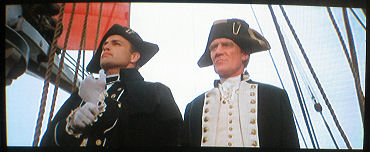I received Warner Home Video’s five-disc Marlon Brando Collection yesterday (it’ll be in stores on 11.7), and spent most of last night watching Mutiny on the Bounty, Julius Caesar, Reflections in a Golden Eye, Teahouse of the August Moon and The Formula. The first three, actually; I can’t stand the latter two (can anyone?), especially Teahouse.
While Mutiny doesn’t play quite as rousingly as I remembered — I’d forgotten how foppy and buffoonish Brando’s Fletcher Christian character is, and how frequently his contentious relationship with Trevor Howard‘s Captain Bligh is played for easy laughs during the first 100 minutes — the extremely wide 2.76 to 1 Ultra Panavision image, shot by Robert Surtees and derived from the original 70mm elements, is really quite beautiful, and the colors are full and luscious.
But the image is so wide (and so narrow in terms of height) that one really needs an extra-large screen to fully appreciate it. It seems too compact on my 36″ Sony flat screen. What I need to do is find someone with a high-def DVD player and a 60″ plasma screen and get myself invited to a viewing party when they purchase a high-def DVD version of this new Bounty. I’ll bring along some Chinese takeout and a bottle of wine.
My difficulties with the jokey humor aside, I have to acknowledge this scene between Howard and Brando, and pay my respects to the way Brando pauses ever so slightly before and after he says the word “fight”. It’s the film’s wittiest moment — the only line that made me laugh out loud.
The decision not to offer a “making of” documentary definitely lessens the interest in this particular DVD. (The main doc on the second disc is called “After the Cam- eras Stopped Rolling: The Journey of the Bounty” — a dull tale about the making of the ship.) It’s a real shame that WHV went the cheapie route in view of the fact that Mutiny on the Bounty‘s production history was one of the most expensive and out-of-control in Hollywood history, and therefore worth recounting for history, like any calamitous event.
Production was marked by constant tempest (Sir Carol Reed, the first director, was let go, and his successor, Lewis Milestone, quit), cost over- runs and Brando’s egoistic big-star behavior. It was almost as prolonged and costly as the shooting of Cleopatra, which opened seven months after Bounty.
Fox Home Video included an ambitious making-of-Cleopatra doc along with their Cleopatra disc three or four years ago, and it’s a far more engaging thing to watch than the film itself. Too bad WHV didn’t follow suit. Laurent Bouzereau or someone on his level could’ve really gone to town with it.


